A Retrospective Study of the Effects of COVID-19 Non-Pharmaceutical Interventions on Influenza in Canada
Abstract
1. Introduction
2. Methodology
2.1. Model
2.2. Fitting
3. Results
4. Discussion
4.1. Limitations
4.2. Future Work
5. Conclusions
Author Contributions
Funding
Institutional Review Board Statement
Informed Consent Statement
Data Availability Statement
Acknowledgments
Conflicts of Interest
References
- Doroshenko, A.; Lee, N.; MacDonald, C.; Zelyas, N.; Asadi, L.; Kanji, J.N. Decline of influenza and respiratory viruses with COVID-19 public health measures: Alberta, Canada. In Proceedings of the Mayo Clinic Proceedings; Elsevier: Amsterdam, The Netherlands, 2021; Volume 96, pp. 3042–3052. [Google Scholar]
- Groves, H.E.; Piché-Renaud, P.P.; Peci, A.; Farrar, D.S.; Buckrell, S.; Bancej, C.; Sevenhuysen, C.; Campigotto, A.; Gubbay, J.B.; Morris, S.K. The impact of the COVID-19 pandemic on influenza, respiratory syncytial virus, and other seasonal respiratory virus circulation in Canada: A population-based study. Lancet Reg. Health 2021, 1, 100015. [Google Scholar]
- Anderson, S.C.; Edwards, A.M.; Yerlanov, M.; Mulberry, N.; Stockdale, J.E.; Iyaniwura, S.A.; Falcao, R.C.; Otterstatter, M.C.; Irvine, M.A.; Janjua, N.Z.; et al. Quantifying the impact of COVID-19 control measures using a Bayesian model of physical distancing. PLoS Comput. Biol. 2020, 16, e1008274. [Google Scholar] [CrossRef]
- Aleta, A.; Martin-Corral, D.; Pastore y Piontti, A.; Ajelli, M.; Litvinova, M.; Chinazzi, M.; Dean, N.E.; Halloran, M.E.; Longini, I.M., Jr.; Merler, S.; et al. Modelling the impact of testing, contact tracing and household quarantine on second waves of COVID-19. Nat. Hum. Behav. 2020, 4, 964–971. [Google Scholar] [CrossRef]
- Karaivanov, A.; Lu, S.E.; Shigeoka, H.; Chen, C.; Pamplona, S. Face masks, public policies and slowing the spread of COVID-19: Evidence from Canada. J. Health Econ. 2021, 78, 102475. [Google Scholar] [CrossRef]
- Peng, A.; Bosco, S.; Tuite, A.; Simmons, A.; Fisman, D. Impact of Community Masking on SARS-CoV-2 Transmission in Ontario after Adjustment for Differential Testing by Age and Sex. medRxiv 2023. [Google Scholar] [CrossRef]
- Moyles, I.R.; Heffernan, J.M.; Kong, J.D. Cost and social distancing dynamics in a mathematical model of COVID-19 with application to Ontario, Canada. R. Soc. Open Sci. 2021, 8, 201770. [Google Scholar] [CrossRef]
- Betti, M.I.; Heffernan, J.M. A simple model for fitting mild, severe, and known cases during an epidemic with an application to the current SARS-CoV-2 pandemic. Infect. Dis. Model. 2021, 6, 313–323. [Google Scholar] [CrossRef]
- Public Health Agency of Canada. FluWatch Annual Report: 2021–2022 Influenza Season. Government of Canada, 2022. Available online: https://www.canada.ca/en/public-health/services/publications/diseases-conditions/fluwatch/2021-2022/annual-report.html (accessed on 25 June 2024).
- Koutsakos, M.; Wheatley, A.K.; Laurie, K.; Kent, S.J.; Rockman, S. Influenza lineage extinction during the COVID-19 pandemic? Nat. Rev. Microbiol. 2021, 19, 741–742. [Google Scholar] [CrossRef]
- Ammi, M.; Desson, Z.W.; Doumbia, M.Z. Non-pharmaceutical interventions and vaccination during COVID-19 in Canada: Implications for COVID and non-COVID outcomes. Health Policy Technol. 2024, 13, 100801. [Google Scholar] [CrossRef]
- Ross, R. Some quantitative studies in epidemiology. Nature 1911, 87, 466–467. [Google Scholar] [CrossRef]
- Chowell, G.; Sattenspiel, L.; Bansal, S.; Viboud, C. Mathematical models to characterize early epidemic growth: A review. Phys. Life Rev. 2016, 18, 66–97. [Google Scholar] [CrossRef]
- Casagrandi, R.; Bolzoni, L.; Levin, S.A.; Andreasen, V. The SIRC model and influenza A. Math. Biosci. 2006, 200, 152–169. [Google Scholar] [CrossRef]
- Nakamura, G.; Grammaticos, B.; Badoual, M. Vaccination strategies for a seasonal epidemic: A simple SIR model. Open Commun. Nonlinear Math. Phys. 2021, 1, 7463. [Google Scholar] [CrossRef]
- Sara, B.; Omar, Z.; Abdessamad, T.; Mostafa, R.; Hanane, F. Parameters’ estimation, sensitivity analysis and model uncertainty for an influenza a mathematical model: Case of morocco. Commun. Math. Biol. Neurosci. 2020, 2020, 4753. [Google Scholar]
- Reed, C.; Chaves, S.S.; Daily Kirley, P.; Emerson, R.; Aragon, D.; Hancock, E.B.; Butler, L.; Baumbach, J.; Hollick, G.; Bennett, N.M.; et al. Estimating influenza disease burden from population-based surveillance data in the United States. PLoS ONE 2015, 10, e0118369. [Google Scholar] [CrossRef]
- Wu, S.L.; Mertens, A.N.; Crider, Y.S.; Nguyen, A.; Pokpongkiat, N.N.; Djajadi, S.; Seth, A.; Hsiang, M.S.; Colford, J.M., Jr.; Reingold, A.; et al. Substantial underestimation of SARS-CoV-2 infection in the United States. Nat. Commun. 2020, 11, 4507. [Google Scholar] [CrossRef]
- Public Health Agency of Canada. Overview of Influenza Monitoring in Canada. 2024. Available online: https://www.canada.ca/en/public-health/services/diseases/flu-influenza/influenza-surveillance/about-fluwatch.html (accessed on 15 February 2025).
- Public Health Agency of Canada. Overview of Influenza Monitoring in Canada. 2019. Available online: https://www.canada.ca/en/public-health/services/diseases/flu-influenza/influenza-surveillance/about-fluwatch.html (accessed on 15 February 2025).
- Kalachev, L.; Landguth, E.L.; Graham, J. Revisiting classical SIR modelling in light of the COVID-19 pandemic. Infect. Dis. Model. 2023, 8, 72–83. [Google Scholar] [CrossRef]
- Schanzer, D.L.; Langley, J.M.; Dummer, T.; Aziz, S. The geographic synchrony of seasonal influenza: A waves across Canada and the United States. PLoS ONE 2011, 6, e21471. [Google Scholar] [CrossRef][Green Version]
- Osthus, D.; Hickmann, K.S.; Caragea, P.C.; Higdon, D.; Del Valle, S.Y. Forecasting seasonal influenza with a state-space SIR model. Ann. Appl. Stat. 2017, 11, 202. [Google Scholar] [CrossRef]
- Boonpatcharanon, S.; Heffernan, J.M.; Jankowski, H. Estimating the basic reproduction number at the beginning of an outbreak. PLoS ONE 2022, 17, e0269306. [Google Scholar] [CrossRef]
- Tuite, A.R.; Fisman, D.N.; Kwong, J.C.; Greer, A.L. Optimal pandemic influenza vaccine allocation strategies for the Canadian population. PLoS ONE 2010, 5, e10520. [Google Scholar] [CrossRef]
- Van den Driessche, P.; Watmough, J. Reproduction numbers and sub-threshold endemic equilibria for compartmental models of disease transmission. Math. Biosci. 2002, 180, 29–48. [Google Scholar] [CrossRef]
- Betti, M.I.; Abouleish, A.H.; Spofford, V.; Peddigrew, C.; Diener, A.; Heffernan, J.M. COVID-19 vaccination and healthcare demand. Bull. Math. Biol. 2023, 85, 32. [Google Scholar] [CrossRef]
- Statistics Canada. Trends in influenza vaccination in Canada, 1996/1997 to 2005. Health Rep. 2007, 18, 82-003-XWE. [Google Scholar]
- Gionet, L. Flu Vaccination Rates in Canada. Statistics Canada, Catalogue No. 82-624-X. 2015. Available online: https://www150.statcan.gc.ca/n1/pub/82-624-x/2015001/article/14218-eng.htm (accessed on 15 February 2025).
- Statistics Canada. Table 13-10-0096-25: Influenza Immunization in the Past 12 Months, by Age Group. 2023. Available online: https://www150.statcan.gc.ca/t1/tbl1/en/tv.action?pid=1310009625 (accessed on 15 February 2025).
- Leonenko, V.N.; Ivanov, S.V. Prediction of influenza peaks in Russian cities: Comparing the accuracy of two SEIR models. Math. Biosci. Eng. 2018, 15, 209–232. [Google Scholar]
- Chakrabarti, A.; Ghosh, J.K. AIC, BIC and recent advances in model selection. In Philosophy of Statistics; Elsevier: Amsterdam, The Netherlands, 2011; pp. 583–605. [Google Scholar]
- Xiang, Y.; Sun, D.Y.; Fan, W.; Gong, X.G. Generalized simulated annealing algorithm and its application to the Thomson model. Phys. Lett. A 1997, 233, 216–220. [Google Scholar] [CrossRef]
- Bjørnstad, O.N.; Viboud, C. Timing and periodicity of influenza epidemics. Proc. Natl. Acad. Sci. USA 2016, 113, 12899–12901. [Google Scholar] [CrossRef]
- Edlund, S.; Kaufman, J.; Lessler, J.; Douglas, J.; Bromberg, M.; Kaufman, Z.; Bassal, R.; Chodick, G.; Marom, R.; Shalev, V.; et al. Comparing three basic models for seasonal influenza. Epidemics 2011, 3, 135–142. [Google Scholar] [CrossRef]
- Public Health Ontario. Ontario res.piratory v.irus t.ool. Public Health Ontario, February 2024. Available online: https://www.publichealthontario.ca/en/Data-and-Analysis/Infectious-Disease/Respiratory-Virus-Tool (accessed on 25 June 2024).
- Institut national de santé publique du Québec. Archives influenza: INSPQ. Government of Québec, 2024. Available online: https://www.inspq.qc.ca/influenza/archives (accessed on 25 June 2024).
- Moghadas, S.M.; Pizzi, N.J.; Wu, J.; Tamblyn, S.E.; Fisman, D.N. Canada in the face of the 2009 H1N1 pandemic. Influenza Other Respir. Viruses 2011, 5, 83–88. [Google Scholar] [CrossRef]
- Government of Alberta. Respiratory Virus Dashboard. Government of Alberta. 2024. Available online: https://www.alberta.ca/stats/dashboard/respiratory-virus-dashboard.htm?data=laboratory-testing#laboratory-testing (accessed on 25 June 2024).
- Patel, M.; Dennis, A.; Flutter, C.; Khan, Z. Pandemic (H1N1) 2009 influenza. Br. J. Anaesth. 2010, 104, 128–142. [Google Scholar] [CrossRef]
- He, D.; Dushoff, J.; Eftimie, R.; Earn, D.J. Patterns of spread of influenza A in Canada. Proc. R. Soc. B Biol. Sci. 2013, 280, 20131174. [Google Scholar] [CrossRef]
- Lagace-Wiens, P.R.; Rubinstein, E.; Gumel, A. Influenza epidemiology—Past, present, and future. Crit. Care Med. 2010, 38, e1–e9. [Google Scholar] [CrossRef]
- Sikora, C.; Fan, S.; Golonka, R.; Sturtevant, D.; Gratrix, J.; Lee, B.E.; Jaipaul, J.; Johnson, M. Transmission of pandemic influenza A (H1N1) 2009 within households: Edmonton, Canada. J. Clin. Virol. 2010, 49, 90–93. [Google Scholar] [CrossRef]
- Lymon, H. Declines in influenza vaccination coverage among health care personnel in acute care hospitals during the COVID-19 pandemic—United States, 2017–2023. MMWR. Morb. Mortal. Wkly. Rep. 2023, 72, 1244–1247. [Google Scholar] [CrossRef]
- Lee, S.S.; Viboud, C.; Petersen, E. Understanding the rebound of influenza in the post COVID-19 pandemic period holds important clues for epidemiology and control. Int. J. Infect. Dis. 2022, 122, 1002–1004. [Google Scholar] [CrossRef]
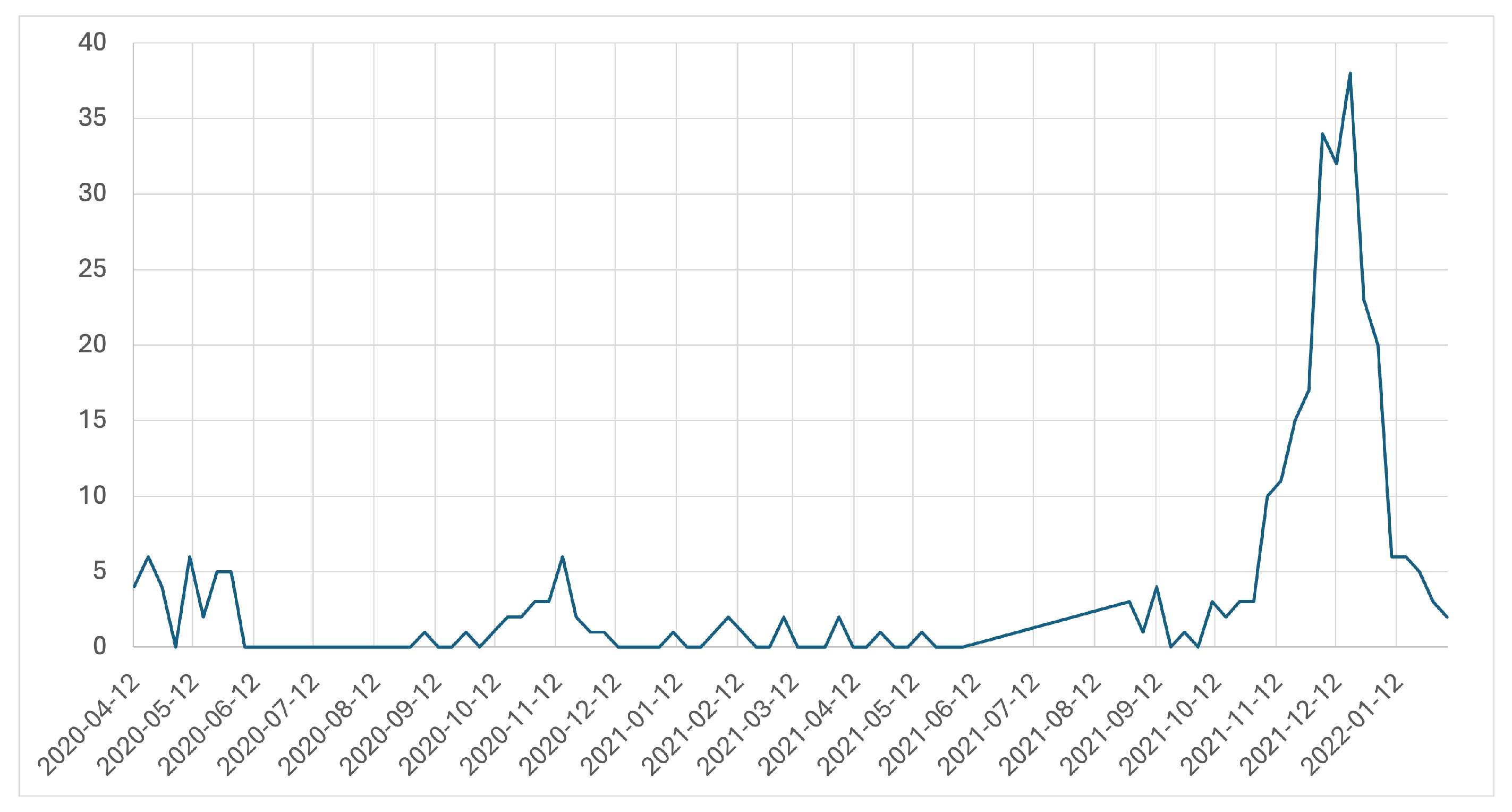
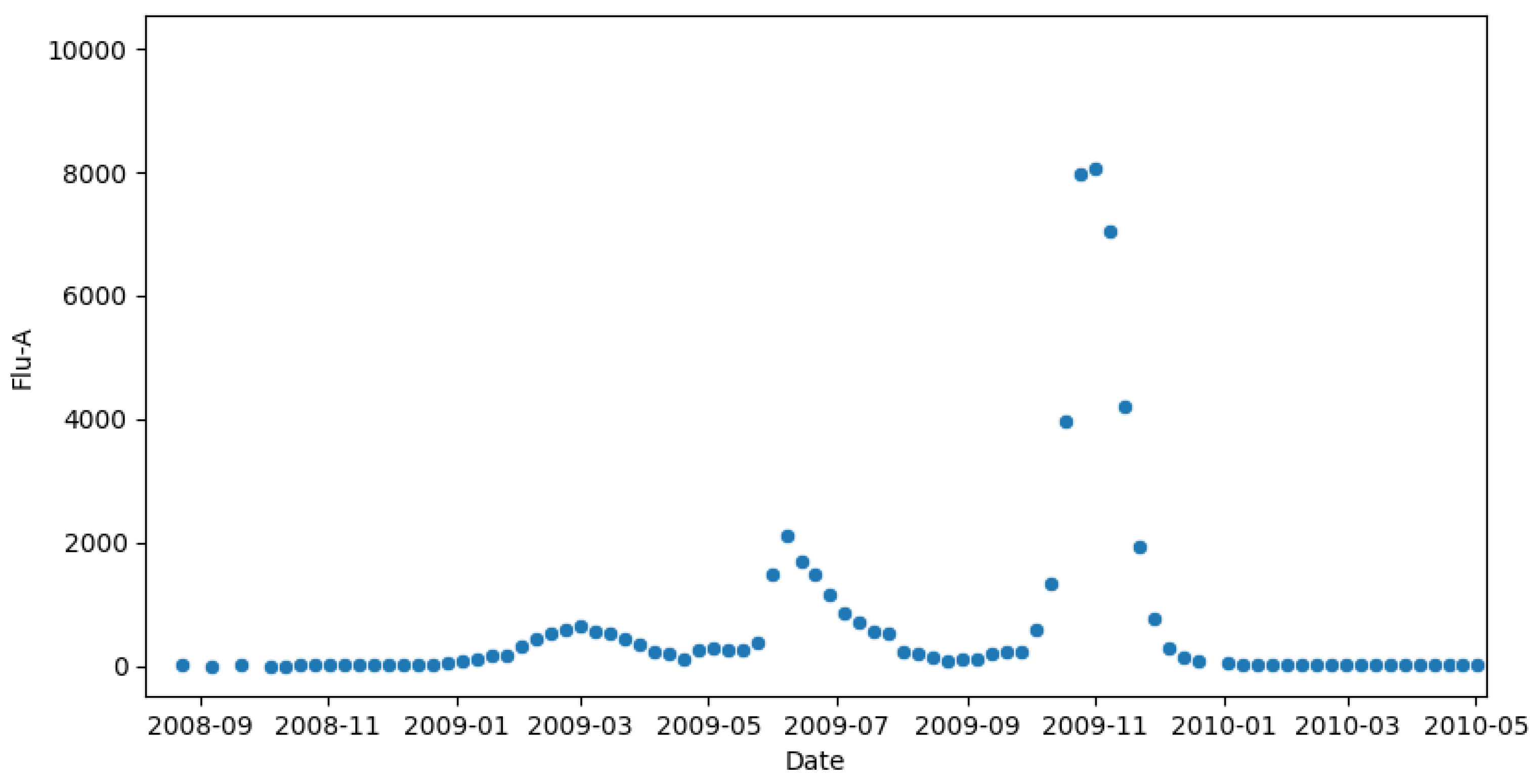

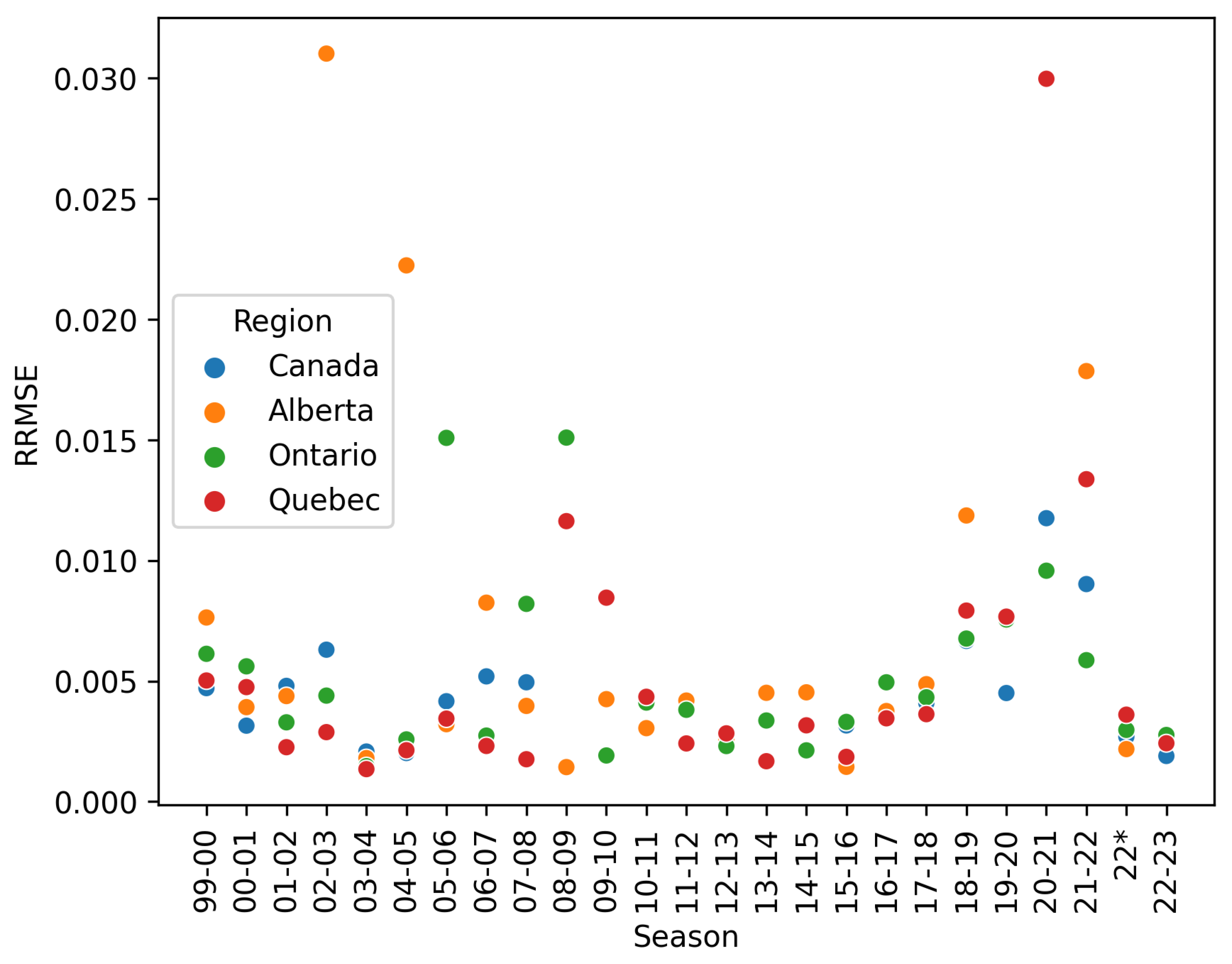
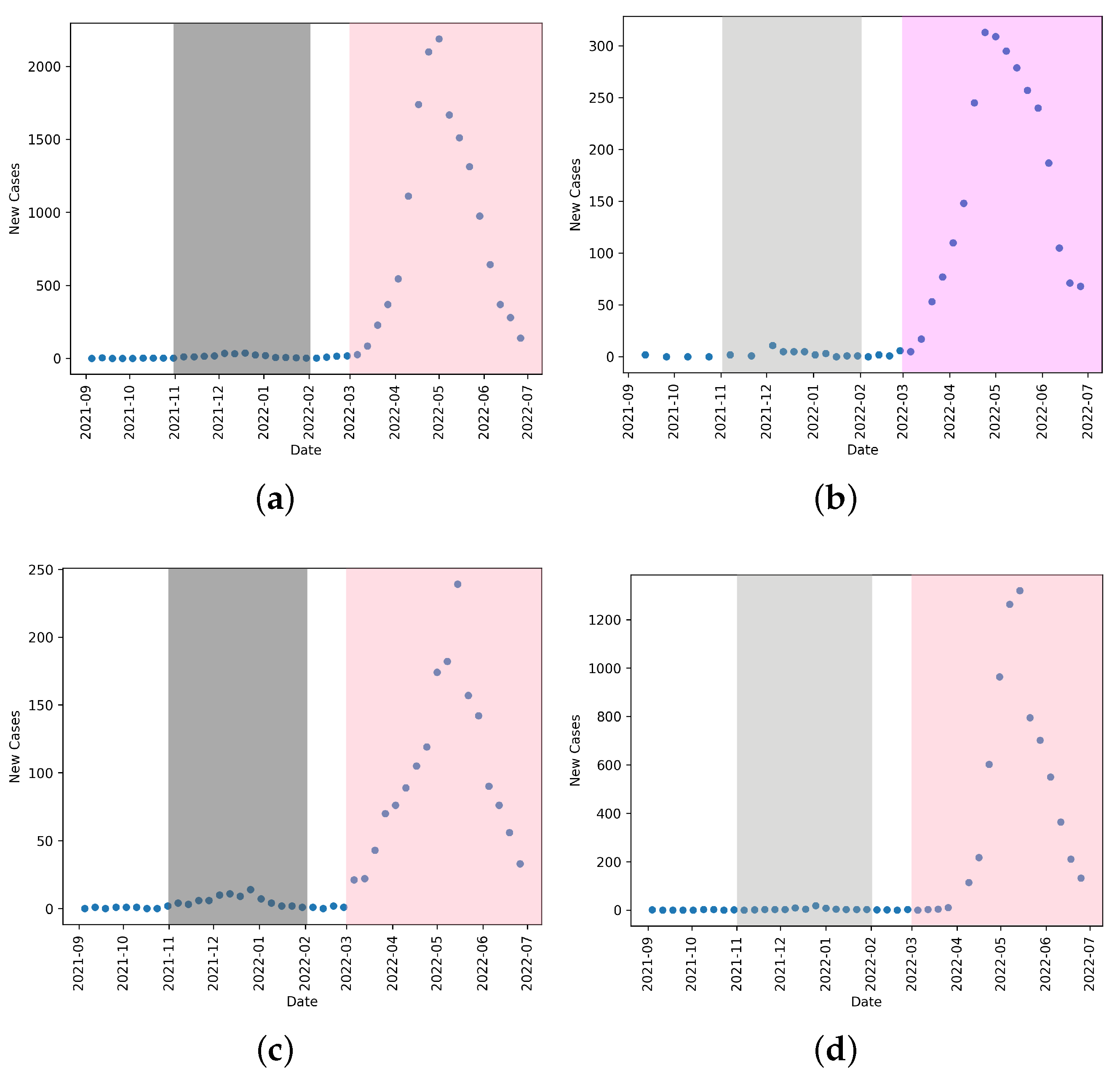
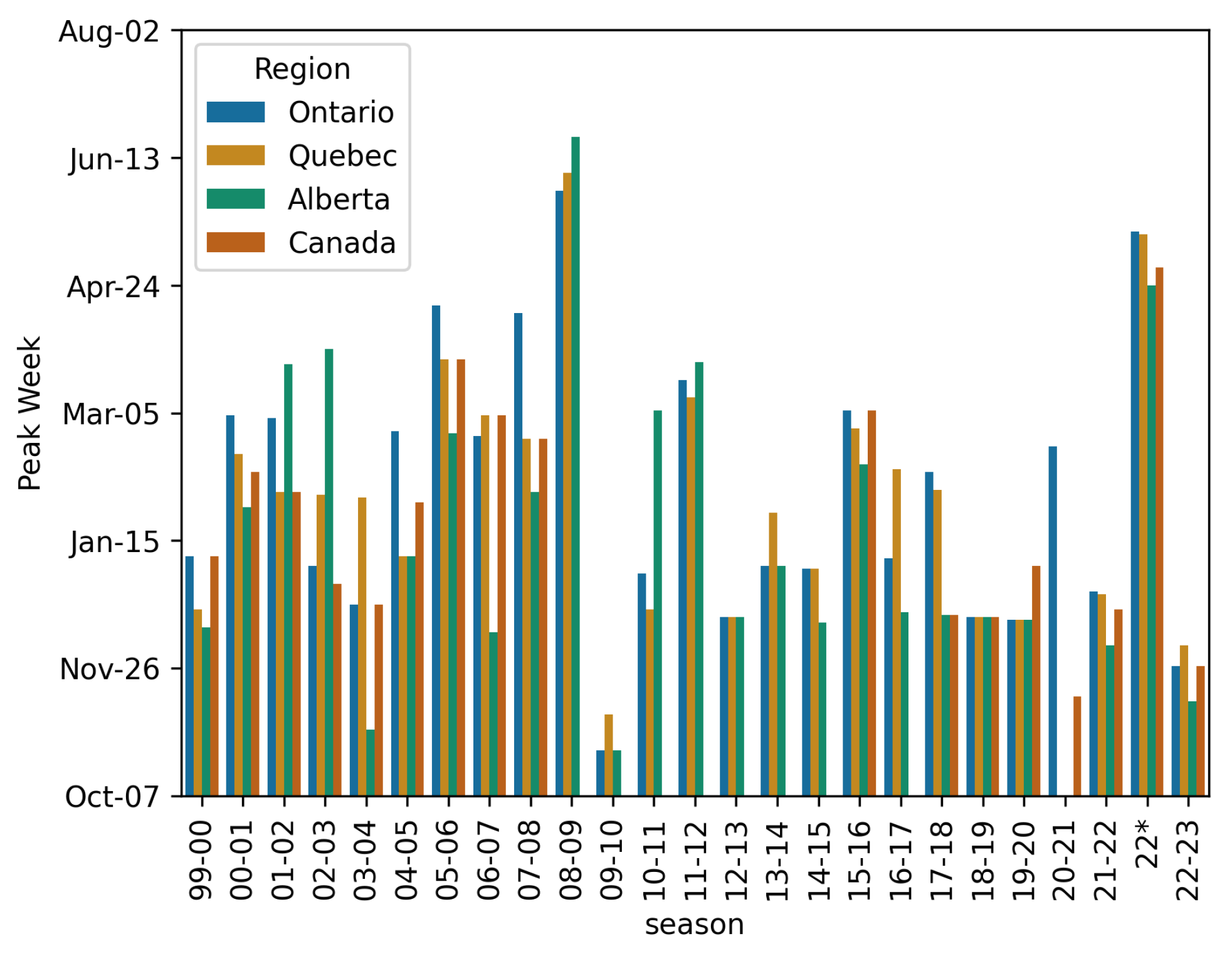
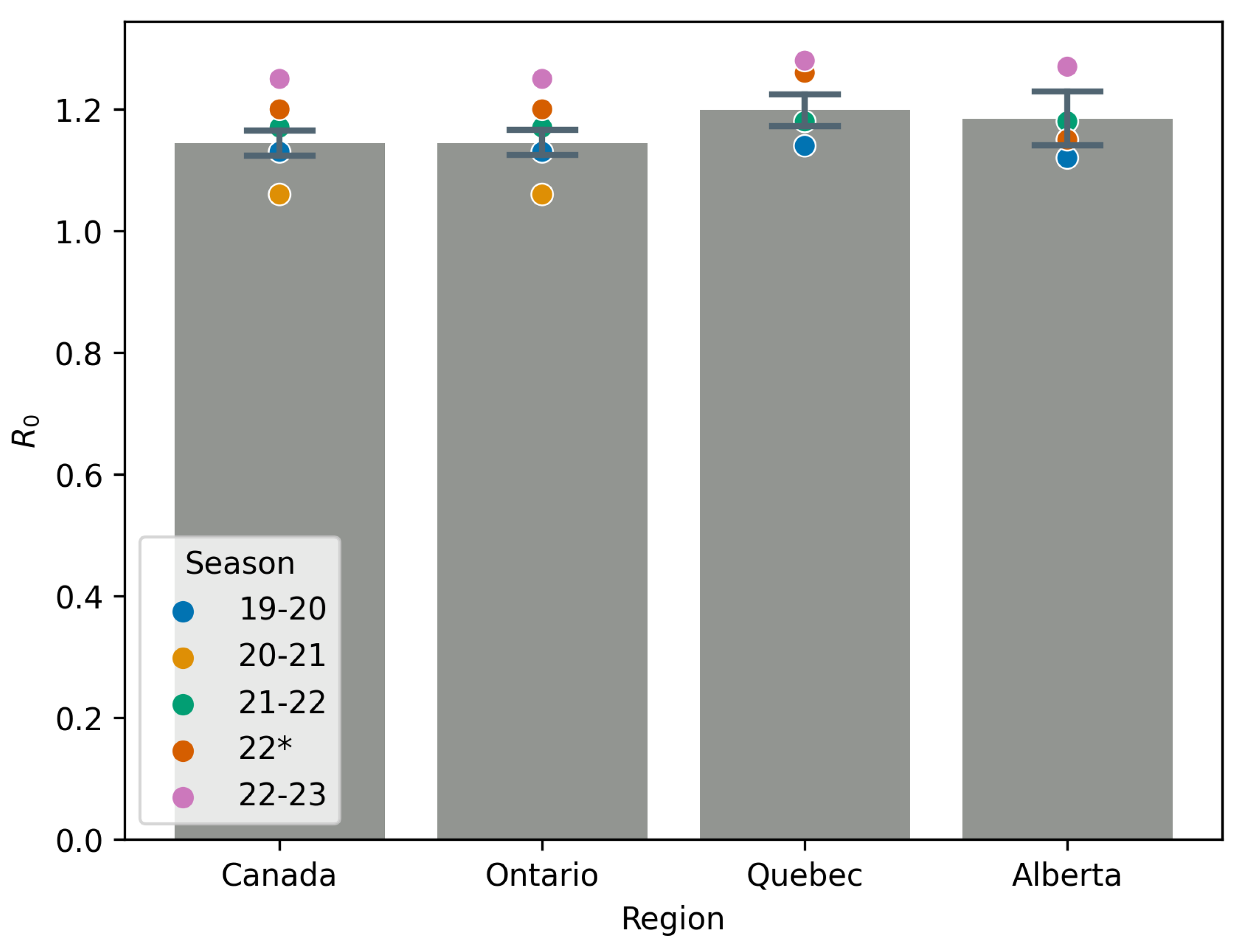
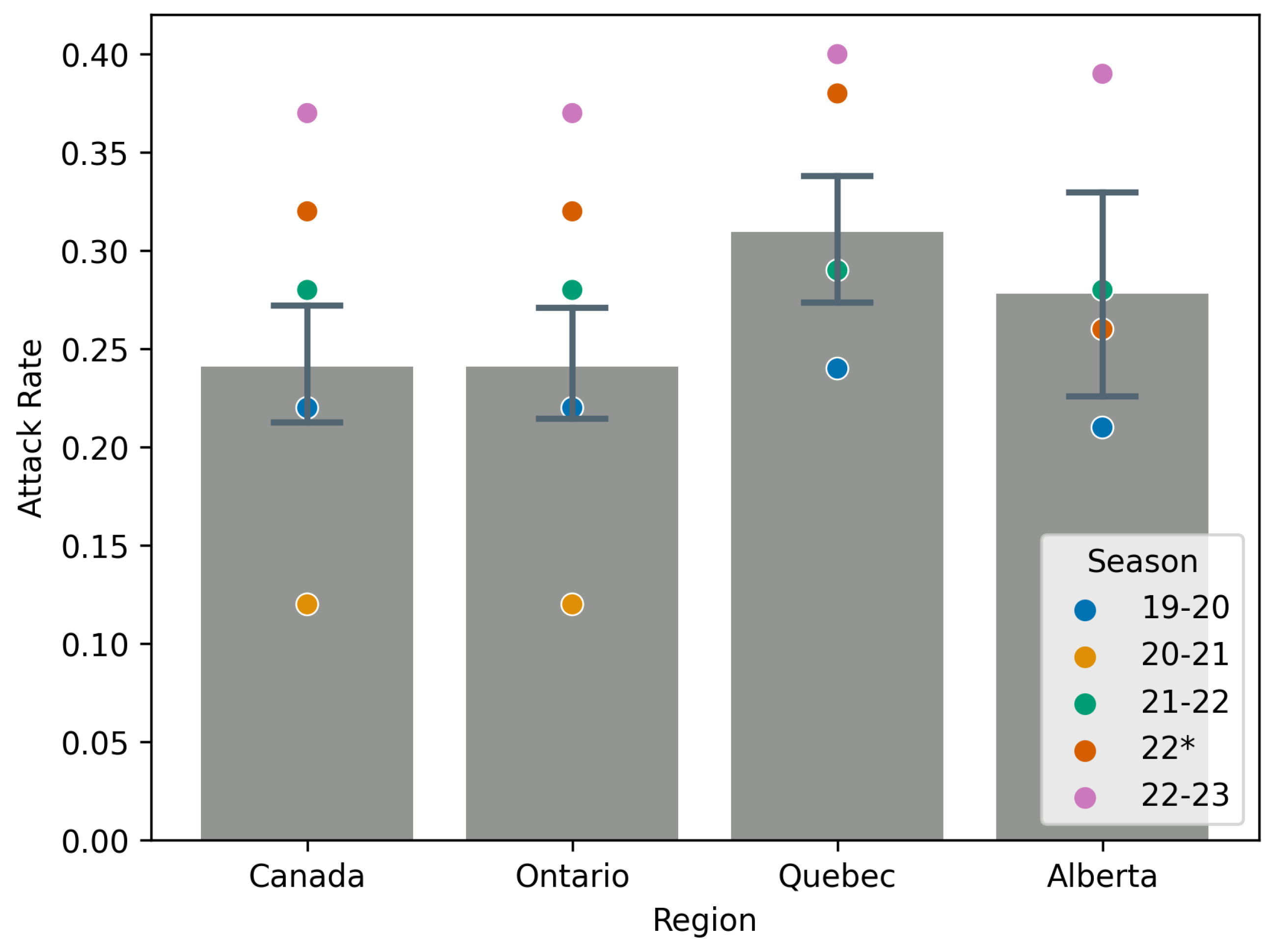
| Year | Vaccination Rate |
|---|---|
| 2003 | 28 |
| 2005 | 34 |
| 2007 | 33 |
| 2009 | 30 |
| 2011 | 30 |
| 2013 | 31 |
| 2015 | 33 |
| 2016 | 32 |
| 2017 | 33 |
| 2018 | 32 |
| 2019 | 34 |
| 2020 | 39 |
| 2021 | – |
| 2022 | 34 |
| Province | Mean SIR AIC | Mean SEIR AIC |
|---|---|---|
| Ontario | 330 | 378 |
| Quebec | 377 | 409 |
| Alberta | −49 | 281 |
| Canada | 350 | 392 |
| Parameter | Value | Fixed |
|---|---|---|
| False | ||
| Total Seasonal Tests or Estimated | False | |
| True | ||
| 1 | False | |
| 0 | True |
| Canada | Alberta | |||||||
| Season | beta | S0 | R0 | Attack Rate | beta | S0 | R0 | Attack Rate |
| 99-00 | 0.00016622 | 20,462.8498 | 1.21473396 | 0.33483552 | 0.00151036 | 2457.57559 | 1.3256531 | 0.44755481 |
| 00-01 | 0.00084378 | 4028.24184 | 1.2139103 | 0.33065638 | 0.00541328 | 652.489663 | 1.26146686 | 0.3837101 |
| 01-02 | 0.00011566 | 27,349.6485 | 1.12971228 | 0.22064108 | 0.00135953 | 2456.36191 | 1.19267561 | 0.30468599 |
| 02-03 | 0.00030219 | 10,261.5702 | 1.10748155 | 0.18811571 | 0.0004846 | 5948.61466 | 1.02952665 | 0.05823518 |
| 03-04 | 6.05 × 10−5 | 52,142.6253 | 1.12735838 | 0.21760458 | 0.00100328 | 3427.25511 | 1.22803561 | 0.34724654 |
| 04-05 | 7.52 × 10−5 | 42,887.2548 | 1.15171921 | 0.25141863 | 0.0001697 | 17004.3483 | 1.03056289 | 0.06476137 |
| 05-06 | 0.00014047 | 22,397.7092 | 1.12365913 | 0.21172432 | 0.00101366 | 3147.40347 | 1.1394265 | 0.23432425 |
| 06-07 | 0.00010339 | 30,877.4116 | 1.140166 | 0.23537004 | 0.00037969 | 7983.6144 | 1.08259861 | 0.14970736 |
| 07-08 | 0.00010339 | 30,877.4116 | 1.140166 | 0.23537004 | 0.00072213 | 4368.71252 | 1.12670388 | 0.21618121 |
| 08-09 | - | - | - | - | 0.00072213 | 4368.71252 | 1.12670388 | 0.21618121 |
| 09-10 | - | - | - | - | 0.00043458 | 9780.91446 | 1.5180509 | 0.5943478 |
| 10-11 | - | - | - | - | 0.00058206 | 5376.39581 | 1.11764071 | 0.20299028 |
| 11-12 | - | - | - | - | 0.00047632 | 6596.29444 | 1.12213486 | 0.20949767 |
| 12-13 | - | - | - | - | 0.00041514 | 7979.79024 | 1.18311704 | 0.29272945 |
| 13-14 | - | - | - | - | 0.00037289 | 9565.34304 | 1.2738693 | 0.39670902 |
| 14-15 | - | - | - | - | 0.00037808 | 9393.82048 | 1.26842327 | 0.39104772 |
| 15-16 | 3.41 × 10−5 | 97,157.9315 | 1.18415282 | 0.294231 | 0.00023391 | 14,072.5729 | 1.17559655 | 0.28306968 |
| 16-17 | - | - | - | - | 0.00023164 | 14,074.295 | 1.16433378 | 0.26844891 |
| 17-18 | 1.82 × 10−5 | 172,721.58 | 1.11996118 | 0.20692799 | 0.00018046 | 18464.4047 | 1.19006223 | 0.30154145 |
| 18-19 | 1.09 × 10−5 | 28,0261.419 | 1.09060028 | 0.16248652 | 0.00010419 | 30140.5105 | 1.12155327 | 0.2100721 |
| 19-20 | 2.10 × 10−5 | 150,376.379 | 1.13046545 | 0.22182137 | 0.00014545 | 21,557.9891 | 1.11987677 | 0.20638974 |
| 20-21 | 0.01075928 | 275.094253 | 1.05707739 | 0.11709196 | - | - | - | - |
| 21-22 | 0.0035854 | 916.891558 | 1.17408102 | 0.284589 | 0.02212772 | 148.882271 | 1.17658036 | 0.28451531 |
| 22 * | 6.93 × 10−5 | 48,541.2115 | 1.2010877 | 0.3249449 | 0.00028839 | 11209.0558 | 1.1544847 | 0.26096192 |
| 22-23 | 2.09 × 10−5 | 166,948.38 | 1.24519128 | 0.36630147 | 0.00015764 | 22485.5027 | 1.26594304 | 0.38850824 |
| Ontario | Quebec | |||||||
| Season | beta | S0 | R0 | Attack Rate | beta | S0 | R0 | Attack Rate |
| 99-00 | 0.00074962 | 4851.85059 | 1.29894834 | 0.4230064 | 0.00077977 | 4342.60522 | 1.20937034 | 0.32530217 |
| 00-01 | 0.00296546 | 1138.75531 | 1.20604749 | 0.32103014 | 0.00541212 | 649.274594 | 1.25498398 | 0.37677228 |
| 01-02 | 0.00088892 | 3725.36893 | 1.18270203 | 0.29216692 | 0.00064844 | 5494.58375 | 1.27246434 | 0.39525457 |
| 02-03 | 0.00177442 | 1942.89855 | 1.23125333 | 0.35153767 | 0.00153609 | 2133.80177 | 1.17061285 | 0.27659946 |
| 03-04 | 0.00046549 | 7789.40159 | 1.29495522 | 0.41827243 | 0.00039401 | 8571.04925 | 1.20610585 | 0.32109775 |
| 04-05 | 0.0003318 | 9905.84902 | 1.1738567 | 0.28081599 | 0.00031742 | 10,819.6541 | 1.22656879 | 0.34515459 |
| 05-06 | 0.00054947 | 5975.2032 | 1.17256237 | 0.27913414 | 0.00089931 | 3894.79047 | 1.25093969 | 0.37239322 |
| 06-07 | 0.00035166 | 9220.84317 | 1.15808148 | 0.25998643 | 0.00081906 | 4307.13253 | 1.25992366 | 0.38206704 |
| 07-08 | 0.00018104 | 16,750.107 | 1.08298577 | 0.14954702 | 0.00040096 | 8148.89306 | 1.16690804 | 0.27173346 |
| 08-09 | 9.53 × 10−5 | 32,397.7244 | 1.10266733 | 0.18025097 | 7.70 × 10−5 | 38,451.7123 | 1.05740624 | 0.10710804 |
| 09-10 | - | - | - | - | - | - | - | - |
| 10-11 | 0.00014013 | 23,577.9282 | 1.18001947 | 0.28877445 | 0.00015133 | 21651.0311 | 1.17014936 | 0.27602551 |
| 11-12 | 0.00086374 | 3730.03208 | 1.15063427 | 0.24987398 | 0.00050017 | 6561.96133 | 1.17216564 | 0.27861838 |
| 12-13 | 0.00014499 | 23,590.2503 | 1.22153541 | 0.33955597 | 0.00017254 | 20,963.9145 | 1.29181146 | 0.41490045 |
| 13-14 | 0.00022792 | 15,057.8952 | 1.22570189 | 0.34435907 | 0.00021373 | 16,006.0153 | 1.22177968 | 0.33962464 |
| 14-15 | 0.00011358 | 29,328.1298 | 1.18968194 | 0.30103562 | 0.00011507 | 29,182.9071 | 1.19935499 | 0.31292873 |
| 15-16 | 0.00015381 | 21,998.8842 | 1.2084727 | 0.32393718 | 0.0001359 | 25391.9529 | 1.23238512 | 0.35179066 |
| 16-17 | 9.34 × 10−5 | 34,930.4781 | 1.16542693 | 0.26989898 | 6.85 × 10−5 | 46505.5978 | 1.13827091 | 0.23275074 |
| 17-18 | 0.00011989 | 26,279.2055 | 1.12525571 | 0.21463281 | 5.66 × 10−5 | 57014.6818 | 1.15221044 | 0.25206623 |
| 18-19 | 0.0001122 | 27,927.841 | 1.11908254 | 0.2056516 | 5.07 × 10−5 | 62989.0653 | 1.14088207 | 0.23646914 |
| 19-20 | 0.0001419 | 23,132.3505 | 1.17228102 | 0.27940252 | 5.73 × 10−5 | 55742.2386 | 1.14034734 | 0.23568172 |
| 20-21 | 0.0093146 | 308.51246 | 1.02631054 | 0.06245293 | - | - | - | - |
| 21-22 | 0.01059945 | 311.293043 | 1.17840484 | 0.29000035 | 0.01365794 | 242.424461 | 1.18250705 | 0.29204132 |
| 22 * | 0.00044435 | 7215.20374 | 1.14502913 | 0.26338778 | 0.00018216 | 19,384.4053 | 1.26108525 | 0.3836769 |
| 22-23 | 5.23 × 10−5 | 64,596.1557 | 1.20684163 | 0.32451261 | 7.90 × 10−5 | 45,305.5685 | 1.27857975 | 0.40156215 |
| Attack Rate | ||||||||
|---|---|---|---|---|---|---|---|---|
| Canada | Alberta | Ontario | Quebec | Canada | Alberta | Ontario | Quebec | |
| Mean | 1.15 ± 0.04 | 1.18 ± 0.11 | 1.18 ± 0.06 | 1.20 ± 0.06 | 0.24 ± 0.05 | 0.28 ± 0.13 | 0.29 ± 0.07 | 0.31 ± 0.07 |
| % Change 20-21 | −7.70 | - | −13.29 | - | −51.37 | - | −78.40 | - |
| % Change 21-22 | 2.51 | −0.62 | −0.45 | −1.43 | 18.19 | 2.10 | 0.30 | −5.45 |
| % Change 22 * | 4.87 | −2.49 | −3.27 | 5.12 | 34.95 | −6.35 | −8.90 | 24.22 |
| % Change 22-23 | 8.72 | 6.93 | 1.96 | 6.57 | 52.13 | 39.42 | 12.24 | 30.01 |
Disclaimer/Publisher’s Note: The statements, opinions and data contained in all publications are solely those of the individual author(s) and contributor(s) and not of MDPI and/or the editor(s). MDPI and/or the editor(s) disclaim responsibility for any injury to people or property resulting from any ideas, methods, instructions or products referred to in the content. |
© 2025 by the authors. Licensee MDPI, Basel, Switzerland. This article is an open access article distributed under the terms and conditions of the Creative Commons Attribution (CC BY) license (https://creativecommons.org/licenses/by/4.0/).
Share and Cite
MacTavish, H.; MacIntyre, K.; Zadeh, P.; Betti, M. A Retrospective Study of the Effects of COVID-19 Non-Pharmaceutical Interventions on Influenza in Canada. Infect. Dis. Rep. 2025, 17, 59. https://doi.org/10.3390/idr17030059
MacTavish H, MacIntyre K, Zadeh P, Betti M. A Retrospective Study of the Effects of COVID-19 Non-Pharmaceutical Interventions on Influenza in Canada. Infectious Disease Reports. 2025; 17(3):59. https://doi.org/10.3390/idr17030059
Chicago/Turabian StyleMacTavish, Heather, Kenzie MacIntyre, Paniz Zadeh, and Matthew Betti. 2025. "A Retrospective Study of the Effects of COVID-19 Non-Pharmaceutical Interventions on Influenza in Canada" Infectious Disease Reports 17, no. 3: 59. https://doi.org/10.3390/idr17030059
APA StyleMacTavish, H., MacIntyre, K., Zadeh, P., & Betti, M. (2025). A Retrospective Study of the Effects of COVID-19 Non-Pharmaceutical Interventions on Influenza in Canada. Infectious Disease Reports, 17(3), 59. https://doi.org/10.3390/idr17030059





